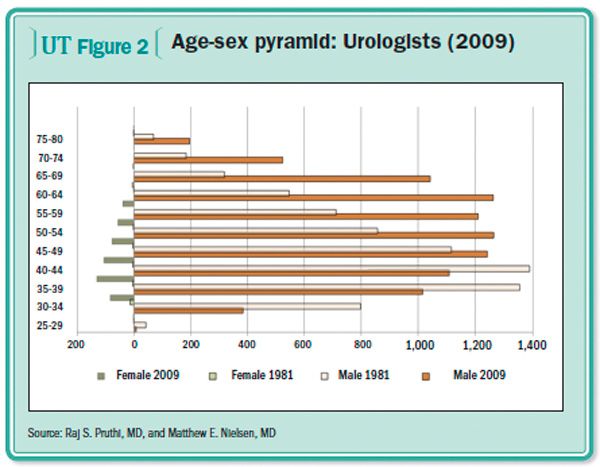Article
Age, gender, and the urology work force: Evolving trends
Recent studies examining the broad impact of the aging population suggest an increasing demand on the overall urology work force, which, when coupled with a changing work force demographic, predicts a significant shortage that is only likely to worsen.


Dr. Pruthi is professor and chairman, and Dr. Nielsen is assistant professor in the department of urology at the University of North Carolina, Chapel Hill. Both are members of the Cecil G. Sheps Center for Health Services Research at UNC Chapel Hill.
Recent studies examining the broad impact of the aging population suggest an increasing demand on the overall urology work force, which, when coupled with a changing work force demographic, predicts a significant shortage that is only likely to worsen. We have recently examined the status of the urology work force in the United States with particular attention to the impact of changes in age and gender makeup of the urologic work force. This work was done in conjunction with the American College of Surgeons’ Health Policy Research Institute at the University of North Carolina at Chapel Hill.
In this article, we examine our findings and what they mean for the future supply of U.S. urologists amid growing demand for urologic services.
An aging urology work force
Our analysis of the age distribution of the urology work force demonstrates an aging population of urologists who are relatively older than physicians in other surgical specialties. In 2009, with an average age of 52.5 years, urology is one of the oldest surgical specialties, second only to thoracic surgeons (53.6 years), compared to 50.9 years for all surgical specialties. The percentage of urologists over the age of 70 years has increased from 3.4% of the work force in 1981 to 7.4% in 2009 (figure 1). Similarly, urologic surgeons over age 55 have increased from 24.6% to 44.0% of the work force during the period 1981 to 2009 (compared to 38.2% for all specialties).

This aging urologist work force begs the question: Is our current and future work force sufficient in numbers and distribution to address the burgeoning burden of urologic diseases? Projections from the U.S. Department of Health and Human Services forecast urology as the medical or surgical subspecialty requiring the greatest percentage increase in the upcoming years, with a projected need of 14,000 urologists by 2015 and 16,000 urologists by 2020. This compares to the less than 9,800 urologists who currently practice in the United States as of 2009. Compounding the paucity of overall urologists relative to the population, the contemporary cohort of urologists is, on average, older than many other specialties, with increasing percentages of the work force over ages 55 and 70.
Aging and subsequently retiring urologists portray a work force supply that is contracting in the face of the growing and aging general population, which will require more, not fewer, urologic health services. The result is a downward trend in urologists per capita, which can only be anticipated to continue moving in the opposite direction of projected demand.
Evolving age-sex structure
The present descriptive analysis also demonstrated an evolving age-sex structure to the urology work force. The relative number of female urologists has grown dramatically over the past several decades, with increasing proportions in younger age cohorts. We can expect this trend to continue as the percentage of female students entering U.S. medical schools is now approximately 50%. This increase has had a downstream effect on surgery in general and urology in particular. There is a growing perception among female medical students that urology is a viable career option. Changes in the culture of residency training and evolution in patients’ perceptions of female physicians/urologists have helped to lower the barriers for women to choose urology as a career.
The 80-hour work week, instituted in 2003, is one ready example of a changing culture and environment potentially favorable to female students. Davis et al have shown that women who completed surgical clerkships prior to 2003 tended to view surgery less favorably than those who completed a clerkship after the duty hour restrictions were put in place. The result is an increasing percentage of women in surgery and urology. It is estimated that females comprise 40% of general surgery residency programs and that the number of female applicants that successfully match into urology residency programs has continued to rise and is now at almost 25%, according to 2013 AUA match statistics.
In our analysis, urology continues to be largely a male specialty. However, women have been entering the urologic work force with increasing frequency: Since 1981, the number of female urologic surgeons has grown from 34 to 512 for an absolute increase of nearly 5% (figure 2). Although this sounds like a small change, it represents a relative increase of more than 1,000%. Still, men continue to make up a solid majority of urologic surgeons, representing 94.8% of the work force.

Since 1981, the age gap between male and female urologists has increased by more than 4 years to an average difference of 10.3 years in 2009, with men being older than women. In 2009, female urologists were 42.7 years old on average and men were 53.0 years old. These trends likely reflect the increased entry of female urologists into the urology work force in more recent years.
Although the impact of this shift in urology remains undefined, in other medical and surgical subspecialties, gender has been shown to potentially have a bearing on one’s choice of surgical sub-specialization as well as career advancement, income, marital status, and having children (Arch Surg 2010; 145:418-24; Arch Surg 2001; 136:649-55; Acad Med 2003; 78:418-28). In evaluating female urologists, some have found high levels of personal, professional, and financial satisfaction with their career choice, but have also noted a significant impact on birth trends, including having children later in life, a smaller number of children, a higher induction rate, and a higher incidence of pregnancy complications.
Furthermore, female physicians, on average, work 7.4 hours less per week than their male counterparts, and a number of studies have revealed the preference of female physicians to work part-time or flexible work hours (Arch Surg 2001; 136:649-55; Acad Med 2003; 78:418-28; Association of Medical Colleges report, “The Complexities of Physician Supply and Demand: Projections Through 2025” [2008]; accessed July 9, 2012). Although such part-time work is likely to improve career satisfaction and quality of life for such physicians, as demonstrated in several questionnaire-based studies, the impact and consequences on the work force supply is uncertain and likely to be restricting.
Conclusion
Amidst federal efforts to restructure health care and possible threats to graduate medical education (GME) funding, it is important to understand the demographic and practice characteristics of the surgical health care work force. Policymakers should contemplate how the various tools of work force policy may affect issues of access. For instance, removing the cap on GME funds, which remains at 1996 levels, would provide one measure to aid all medical and surgical specialties (including urology) to recalibrate to an appropriate per capita supply rate. This solution to the work force access dilemma may be politically challenging in an era of contracting governmental funding across the board. However, the degree and magnitude of the anticipated access problem argues for focused advocacy on the part of urologists and organized urology.UT





